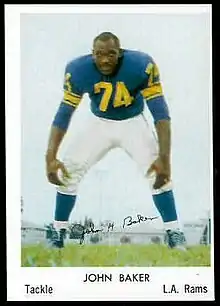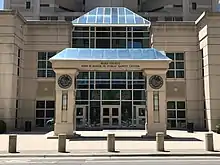John H. Baker Jr.
John Haywood Baker Jr. (June 10, 1935 – October 31, 2007), nicknamed "Big John", was an American defensive lineman in the National Football League who played for four teams from 1958 to 1968.
John Baker Jr. | |
|---|---|
 Baker in 1959 | |
| Sheriff of Wake County, North Carolina | |
| In office 1978–2002 | |
| Personal details | |
| Born | June 10, 1935 Raleigh, North Carolina |
| Died | October 31, 2007 (aged 72) Raleigh, North Carolina |
| Political party | Democratic |
| No. 73, 78 | |||||||||
|---|---|---|---|---|---|---|---|---|---|
| Position: | DE / DT | ||||||||
| Career information | |||||||||
| High school: | Raleigh (NC) Washington | ||||||||
| College: | North Carolina Central | ||||||||
| NFL Draft: | 1958 / Round: 5 / Pick: 56 | ||||||||
| Career history | |||||||||
| Career NFL statistics | |||||||||
| |||||||||
| Player stats at PFR | |||||||||
He later served as sheriff of Wake County, North Carolina from 1978 to 2002, becoming the first African-American sheriff in North Carolina since the Reconstruction era.[1]
Early life and education
John H. Baker was born on June 10, 1935[2] in Raleigh, North Carolina. He was the son of John H. Baker Sr., the city's first African-American police officer.[1]
The young Baker attended Raleigh's Washington and Ligon High Schools and North Carolina Central University, where he graduated in 1958.[3] There he was a teammate of Herman Boone.
In 1959 Baker married a woman named Juanita. They remained married until his death.[4]
Career
In the fifth round of the 1958 NFL Draft, Baker was selected by the Los Angeles Rams. Over eleven seasons he played for the Rams (1958–61), Philadelphia Eagles (1962), Pittsburgh Steelers (1963–67) and Detroit Lions (1968). With the Steelers, he was famous for his tackle on New York Giants quarterback Y. A. Tittle in 1964, which left Tittle bloodied and helmet-less.
After Baker retired from the NFL, he worked as an aide for then-U.S. Senator Robert Morgan. He was also appointed to the state Parole Commission in 1970, the first black person to do so.[5] Baker was a member of the "Oval Table Gang", an informal group of black Raleigh community leaders that met in Ralph Campbell Sr.'s home to discuss strategies to desegregate Raleigh schools, plan demonstrations, and assist black candidates for public office.[6] He began speaking to youth in community centers and in prison, trying to help them change their lives for good. In 1976 Baker worked on the state presidential campaign of Jimmy Carter.
In 1978, Baker ran for sheriff of Wake County and won. He was repeatedly re-elected and held the position for 24 years. He instituted a way for incarcerated youth to continue their education, and was instrumental in founding the John H. Baker Charter School (which was named after him.)
In 2002 Baker was defeated for re-election as sheriff by Donnie Harrison. He was unsuccessful in a 2006 campaign to regain the office.
Legacy and honors

- 1972 – He was inducted into the North Carolina Sports Hall of Fame.
- 2007 – both Baker Jr. and his father Baker Sr. were inducted into the Raleigh Hall of Fame.[1]
- 2008 – The Wake Country Public Safety Center was renamed after John H. Baker Jr. to honor his long service as sheriff.[7]
References
- McDonald, Thomasi (October 31, 2007). "Former Wake Sheriff John Baker dies". The News & Observer. Archived from the original on May 14, 2007. Retrieved October 31, 2007.
- Utterback, Bill (1989). "Former Steeler Baker Still the Enforcer" (PDF). The Coffin Corner. Professional Football Researchers Association. 11 (1). Retrieved August 31, 2017.
- "Former Sheriff John Baker Dies at 72". www.wral.com. WRAL News. November 5, 2007. Retrieved May 23, 2016.
- Seligson, Paula (June 28, 2013). "Juanita Baker, 78, trailblazer in NC Department of Correction, dies". The News & Observer. Retrieved November 3, 2018.
- John H. Baker (1935-2007)
- Price, Jay (January 13, 2011). "Ralph Campbell, 64; broke color barrier in state politics". The News & Observer.
- News & Observer: Building to get longtime sheriff's name today. Retrieved on September 15, 2008.